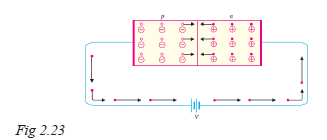- We shall now see how current flows across pn junction when it is forward biased. Fig. 2.23 shows a forward biased pn junction. Under the influence of forward voltage, the free electrons in n-type move towards the junction, leaving behind positively charged atoms. However, more electrons arrive from the negative battery terminal and enter the n-region to take up their places. As the free electrons reach the junction, they become valence electrons. As valence electrons, they move through the holes in the p- region. The valence electrons move towards left in the p-region which is equivalent to the holes moving to right. When the valence electrons reach the left end of the crystal, they flow into the positive terminal of the battery.

- The mechanism of current flow in a forward biased pn junction can be summed up as under:
(i) The free electrons from the negative terminal continue to pour into the n-region while the free electrons in the n-region move towards the junction.
(ii) The electrons travel through the n-region as free-electrons i.e. current in n-region is by free electrons.
(iii) When these electrons reach the junction, they combine with holes and become valence electrons.
(iv) The electrons travel through p-region as valence electrons i.e. current in the p-region is by holes.
(v) When these valence electrons reach the left end of crystal, they flow into the positive terminal of the battery.
- From the above discussion, it is concluded that in n-type region, current is carried by free electrons whereas in p-type region, it is carried by holes. However, in the external connecting wires, the current is carried by free electrons.
Wilfykil answered the question on
August 14, 2019 at 05:45